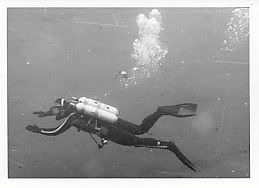The owner of the dive shop I go to loves to give me a hard time over my gear preferences, but it is all just good natured ribbing. He is older than I am and used to use the same stuff years ago. In rare moments of candor, he agrees with my choices for the same reason I have for choosing them. But I am sure he is gonna have a field day teasing me about my twin setup!
Recently, he asked me to bring my stuff down to his shop and get into the pool with one of his classes. I used a single 72 with J valve, my DA Aqua-Master, one five pound weight, a watch and a capillary depth gauge. No BC and no SPG. After a short talk on the beginnings of SCUBA and how a diver can safely dive with minimum gear, I was given strict instructions to not resurface for any reason until, by calculating my air consumption by watch alone (but before my J valve started honking), I figured myself to be at about 500 PSI.
We all got into the water and I knelt in the deep end (12') of the pool and watched the class up in the shallow end until they all came down to join me. The class went through air sharing drills using their octopuses. When they were done, my friend came over to me and gave me the out of air signal. We then buddy breathed for five minutes using my Aqua-Master. Then he returned to his class and began buddy breathing with them until they all could do it flawlessly.
Near the end of the pool time, he signaled for me to take my tank off. I pulled it over my head and placed it on the bottom. Doing the old "blow and go," I went to the surface, grabbed a lungful of air and shot back down to put my tank back on.
When I figured I had about 500 PSI left in the tank, I headed for the shallow end. My J valved hadn't started honking yet (which it does at 500 PSI) but I knew it wouldn't be long. I climbed out of the water and set my rig aside to wait for the rest to get finished with the class.
When they were done and everyone was out of the pool, my friend put his Titan on my tank and opened the valve. The gauge read about 550 PSI. He held it out for his students to see. He then gave a little talk about how all the new technologies make it easier to learn to dive but that the new devices should be viewed as conveniences and not used as crutches in place of skill. He then offered to teach the old skills, free of charge, to anyone interested in learning them. Five of the six students expressed an interest in the extra training. The lone holdout was a kid of 18 or 19 who was an obvious tech junkie. When the class was over, the tech junkie grabbed his stuff and left. The other five attacked me with a barrage of questions about my gear and how I use it. One even asked me where she (yes, she) could get a DH reg. She liked the idea of having the exhaust bubbles behind her instead of roaring passed her face.
I got a free fill out of the deal and had a good time to boot.





